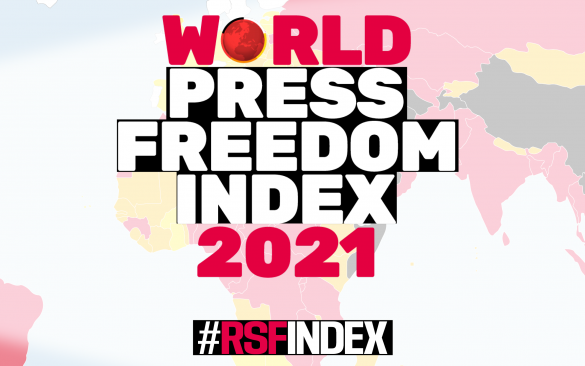By SAT News Desk
MELBOURNE, April 24, 2021: People globally are bearing the wrath of the COVID-19 pandemic since last year and tragic deaths have shattered humankind. Life remains disrupted in many countries and despite many vaccines in the market, the unfolding agony of this unprecedented crisis does not seem to end. Unfortunately, along with this crisis, another crisis of disinformation, has gripped the world.
This year’s #RSFINDEX, which evaluates the press freedom situation in 180 countries and territories annually, shows that journalism, journalism, which is arguably the best vaccine against the virus of disinformation, is totally blocked or seriously impeded in 73 countries and constrained in 59 others, which together represent 73% of the countries evaluated. These countries are classified as having “very bad,” “bad” or “problematic” environments for press freedom, and are identified accordingly in black, red, or orange on the World Press Freedom map.
The Index data, compiled by the Reporters Without Borders (RSF) reflects a dramatic deterioration in people’s access to information and an increase in obstacles to news coverage. The coronavirus pandemic has been used as grounds to block journalists’ access to information sources and reporting in the field. Will this access be restored when the pandemic is over? The data shows that journalists are finding it increasingly hard to investigate and report sensitive stories, especially in Asia, the Middle East, and Europe.
“Journalism is the best vaccine against disinformation,” RSF secretary-general Christophe Deloire said. “Unfortunately, its production and distribution are too often blocked by political, economic, technological and, sometimes, even cultural factors. In response to the virality of disinformation across borders, on digital platforms and via social media, journalism provides the most effective means of ensuring that public debate is based on a diverse range of established facts.”
Norway is ranked first in the Index for the fifth year running even though its media have complained of a lack of access to state-held information about the pandemic. Finland maintained its position in second place while Sweden (up 1 at 3rd) recovered its third place ranking, which it had yielded to Denmark (down 1 at 4th) last year. The 2021 Index demonstrates the success of these Nordic nations’ approach towards upholding press freedom.
The World Press Freedom map has not had so few countries coloured white – indicating a country situation that is at least good if not optimal – since 2013, when the current evaluation method was adopted. This year, only 12 of the Index’s 180 countries (7%) can claim to offer a favourable environment for journalism, as opposed to 13 countries (8%) last year. The country to have been stripped of its “good” classification is Germany (down 2 at 13th). Dozens of its journalists were attacked by supporters of extremist and conspiracy theory believers during protests against pandemic restrictions.
CLICK TO SEE INFOGRAM
The press freedom situation in Germany is nonetheless still classified as “fairly good,” as is the case in the United States (down 1 at 44th), despite the fact that Donald Trump’s final year in the White House was marked by a record number of assaults against journalists (around 400) and arrests of members of the media (130), according to the US Press Freedom Tracker, of which RSF is a partner. As a result of falling four places, Brazil joined the countries coloured red, indicating that the press freedom situation there is classified as “bad”. The vilification and orchestrated public humiliation of journalists have become trademarks of President Bolsonaro, along with his family and closest allies. Brazil shares the “bad” classification with India (142nd), Mexico (143rd) and Russia (down 1 at 150th), which deployed its repressive apparatus to limit media coverage of protests in support of Kremlin opponent, Alexei Navalny.
China (177th), which continues to take Internet censorship, surveillance and propaganda to unprecedented levels, is still firmly anchored among the Index’s worst countries, which are indicated in black on the World Press Freedom map. Right below China is the same trio of totalitarian countries that have historically occupied the bottom three places. Two are Asian: Turkmenistan (up 1 at 178th) and North Korea (up 1 at 179th). The third is African: Eritrea (down 2 at 180th). Regardless of their continent, these countries maintain absolute control over all news and information, enabling the first two to claim they had no Covid-19 cases and the third to maintain complete silence about the fate of 11 journalists who were arrested 20 years ago, some of whom have allegedly been held in metal containers in the middle of a desert.
The country that fell the furthest in 2021 was Malaysia (down 18 at 119th), where the problems include a recent “anti-fake news” decree allowing the government to impose its own version of the truth. Big descents were also registered by Comoros (down 9 at 84th) and El Salvador (down 8 at 82nd), where journalists have struggled to obtain state-held information about the government’s handling of the pandemic. Most of the 2021 Index’s biggest gains are in Africa. Burundi (up 13 at 147th), Sierra Leone (up 10 at 75th), and Mali (up 9 at 99th) have all seen significant improvements, including the release of four journalists with the independent Burundian media Iwacu, the repeal of a law criminalising press offences in Sierra Leone and a fall in the number of abuses in Mali.
Source- rsf.org






